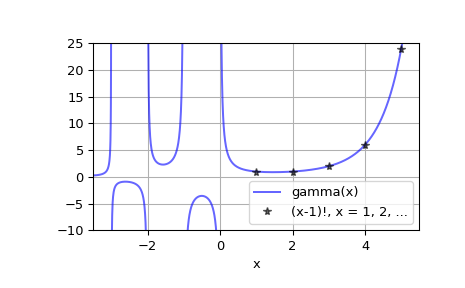gamma#
- scipy.special.gamma(z, out=None)#
gamma function.
The gamma function is defined as
\[\Gamma(z) = \int_0^\infty t^{z-1} e^{-t} dt\]for \(\Re(z) > 0\) and is extended to the rest of the complex plane by analytic continuation. See [dlmf] for more details.
- Parameters:
- zarray_like
Real or complex valued argument
- outndarray, optional
Optional output array for the function values
- Returns:
- scalar or ndarray
Values of the gamma function
Notes
The gamma function is often referred to as the generalized factorial since \(\Gamma(n + 1) = n!\) for natural numbers \(n\). More generally it satisfies the recurrence relation \(\Gamma(z + 1) = z \cdot \Gamma(z)\) for complex \(z\), which, combined with the fact that \(\Gamma(1) = 1\), implies the above identity for \(z = n\).
The gamma function has poles at non-negative integers and the sign of infinity as z approaches each pole depends upon the direction in which the pole is approached. For this reason, the consistent thing is for gamma(z) to return NaN at negative integers, and to return -inf when x = -0.0 and +inf when x = 0.0, using the signbit of zero to signify the direction in which the origin is being approached. This is for instance what is recommended for the gamma function in annex F entry 9.5.4 of the Iso C 99 standard [isoc99].
Prior to SciPy version 1.15,
scipy.special.gamma(z)returned+infat each pole. This was fixed in version 1.15, but with the following consequence. Expressions where gamma appears in the denominator such asgamma(u) * gamma(v) / (gamma(w) * gamma(x))no longer evaluate to 0 if the numerator is well defined but there is a pole in the denominator. Instead such expressions evaluate to NaN. We recommend instead using the function
rgammafor the reciprocal gamma function in such cases. The above expression could for instance be written asgamma(u) * gamma(v) * (rgamma(w) * rgamma(x))Array API Standard Support
gammahas experimental support for Python Array API Standard compatible backends in addition to NumPy. Please consider testing these features by setting an environment variableSCIPY_ARRAY_API=1and providing CuPy, PyTorch, JAX, or Dask arrays as array arguments. The following combinations of backend and device (or other capability) are supported.Library
CPU
GPU
NumPy
✅
n/a
CuPy
n/a
✅
PyTorch
✅
⛔
JAX
✅
✅
Dask
✅
n/a
See Support for the array API standard for more information.
References
[dlmf]NIST Digital Library of Mathematical Functions https://dlmf.nist.gov/5.2#E1
Examples
>>> import numpy as np >>> from scipy.special import gamma, factorial
>>> gamma([0, 0.5, 1, 5]) array([ inf, 1.77245385, 1. , 24. ])
>>> z = 2.5 + 1j >>> gamma(z) (0.77476210455108352+0.70763120437959293j) >>> gamma(z+1), z*gamma(z) # Recurrence property ((1.2292740569981171+2.5438401155000685j), (1.2292740569981158+2.5438401155000658j))
>>> gamma(0.5)**2 # gamma(0.5) = sqrt(pi) 3.1415926535897927
Plot gamma(x) for real x
>>> x = np.linspace(-3.5, 5.5, 2251) >>> y = gamma(x)
>>> import matplotlib.pyplot as plt >>> plt.plot(x, y, 'b', alpha=0.6, label='gamma(x)') >>> k = np.arange(1, 7) >>> plt.plot(k, factorial(k-1), 'k*', alpha=0.6, ... label='(x-1)!, x = 1, 2, ...') >>> plt.xlim(-3.5, 5.5) >>> plt.ylim(-10, 25) >>> plt.grid() >>> plt.xlabel('x') >>> plt.legend(loc='lower right') >>> plt.show()
